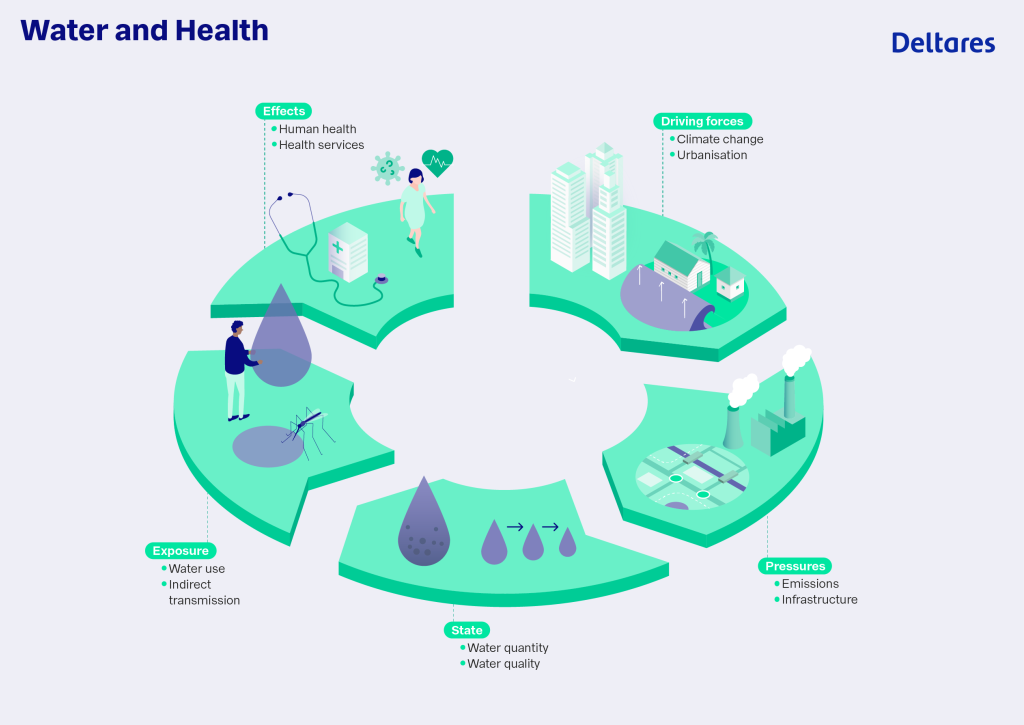Using knowledge about water, soil and health to stay healthy
Climate change, sea level rise, and land subsidence pose increasing health risks in densely populated areas. Floods, droughts, and changes in water and soil quality can lead to disease outbreaks and other health problems. Policy- and decision-makers working for government and water authorities need reliable insights to reduce these risks. Deltares provides expertise and data on water, soil, and health to help them reduce or prevent climate-related diseases and other health effects.

Specific topics
-
Pollutants and their consequences for water quality and health
-
The solution for toxic algal blooms is to tackle them at the source
-
A fully circular economy requires the efficient use of essential resources
-
Floods and droughts in catchments and the consequences for health
-
The consequences of plastic pollution
-
Ensuring soils are healthy: both now and in the future
The connection and co-creation of knowledge at the interface of Deltares knowledge about water and the subsurface on the one hand, and biomedical developments on the other, are important to mitigate health risks. We always keep an eye on the effects on both the ecosystem and human health. We combine our data with the data of our health partners so thatwe can identify health risks early and as an integral part of the system.
For water managers, municipal authorities and our partners in the biomedical field, we propose measures to transform health risks into health gains wherever possible.
Eline Boelee, expert water and health
Deltares strives after a healthy living environment for healthy people
We study heat stress in cities, investigate the health effects of climate adaptation, the impact of toxic algal blooms, pollutants in water and the subsurface such as hormones, trace pharmaceuticals and antibiotics, and the health risks associated with water-based leisure activities. That involves measuring water quality, modelling and predicting risks.
Our work always focuses on improving human health through the optimal management of the living environment. By linking our knowledge with that of our health partners, we help our clients reduce disease burdens and take steps that allow people to live healthy lives in increasingly densely populated environments.

We repeatedly ask three questions:
- what is happening in people's living environments?
- what are the negative or positive health effects?
- what needs to be changed in our environment?
From health risks to health gains
To establish a clear picture of the effects that floods have on health, we look at them from different perspectives. They can include physical damage, mental stress, symptoms linked to food and drinking water, diseases transmitted by mosquitoes, serious contamination from chemical plants, and mould.
To combat heat stress in cities, and the associated health risks, we look at whether climate adaptation measures do not result in health problems of their own. Mosquitoes may breed in swales, for example, or actually thrive in shallow urban lakes. At the same time, rising temperatures and warmer water are also sources of pathogens.
One example is Erasmus MC's One Health PACT project led by Marion Koopmans. The research concentrates on diseases transmitted by mosquitoes. ‘We are looking at the link between land use and climate change, and how that affects mosquitoes, the diseases they can transmit and human exposure to mosquitoes,’ explains Deltares expert Eline Boelee. ‘At all times, the focus is on new developments and how they might affect health. For example, if there is a sudden rise in mosquitoes somewhere. Have numbers really risen? And which species are involved? And above all, where?

Knowledge about occurrences
We also monitor rises in toxic blue-green algae. These are found in both coastal waters and fresh water. The same applies to floods. Where can they occur? Will the water pass over an industrial area? Or over a wastewater treatment plant or through an area in the tropics where there are large numbers of latrines? What are the implications for the chemical and microbiological contamination of the water? Those being the areas were we already have a good knowledge base.


